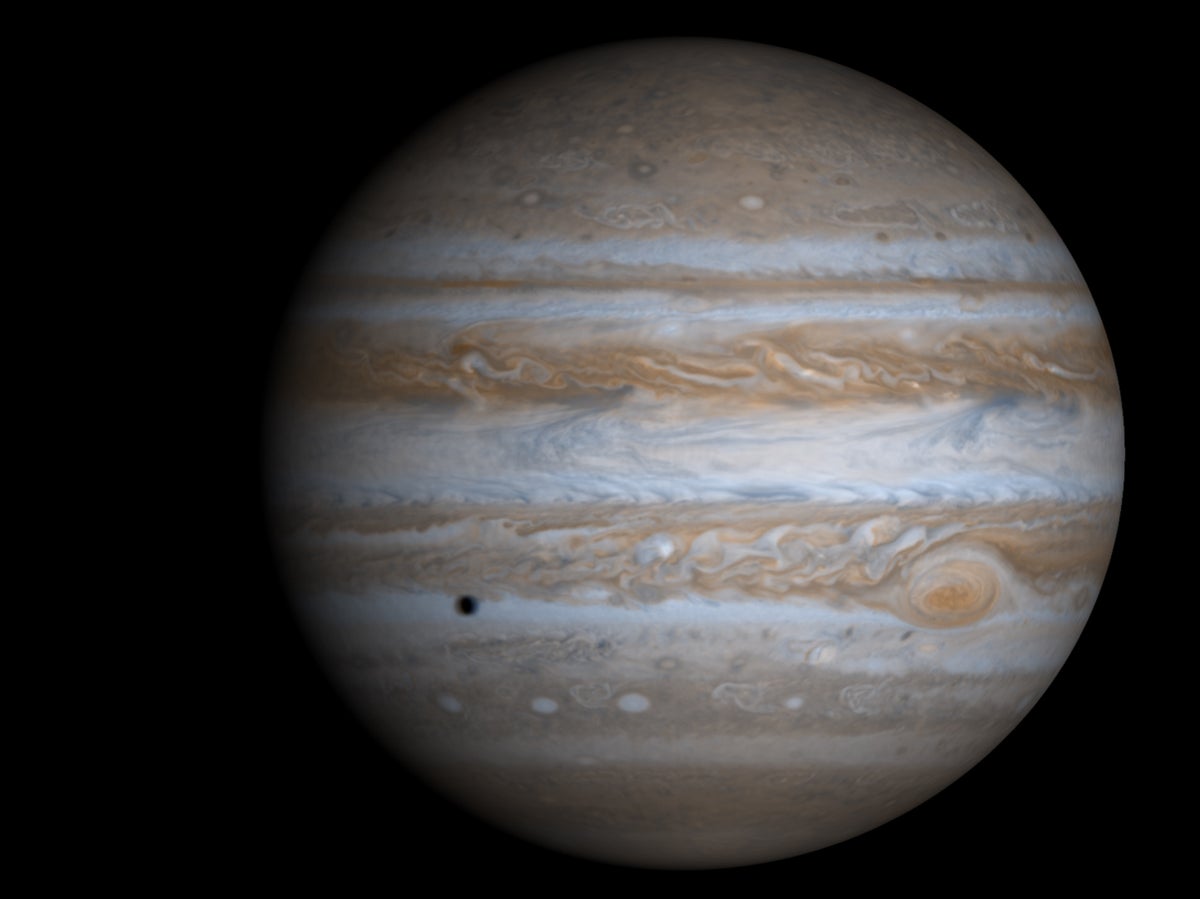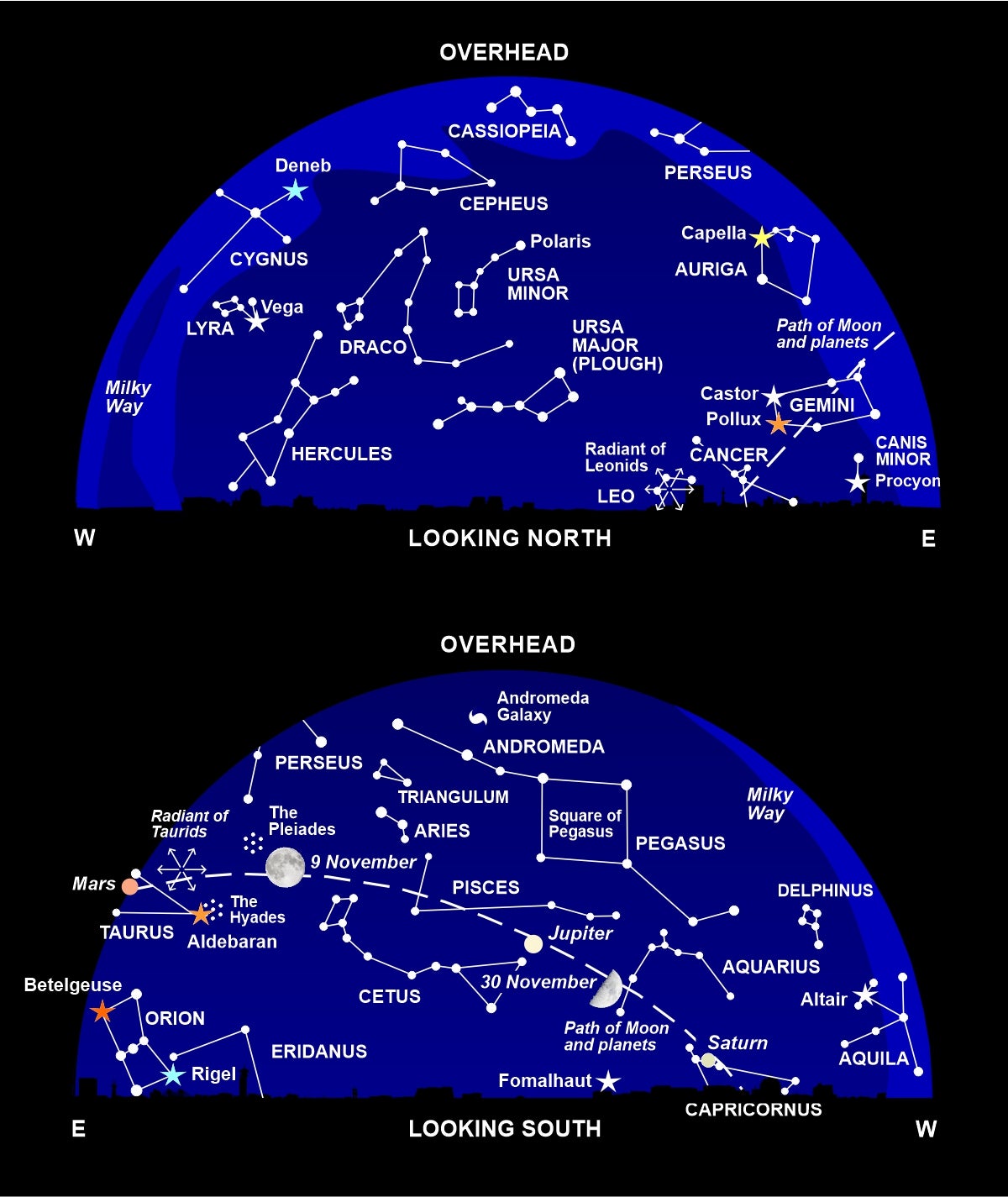
You can’t miss brilliant Mars over in the east, its warm colour cheering up these dank November evenings. The Red Planet is currently moving slowly but surely against the stars that form the familiar constellation of Taurus (the Bull). Early astronomers around the world knew that planets like Mars are restless inhabitants of the night sky, and the word “planet” actually derives from the Greek for “wanderer”.
If you’re keeping more than a casual eye on Mars, though, you’ll notice its path through the heavens has changed. For months the red planet has been moving right to left, but a few days ago it ground to a halt, and Mars is now travelling from left to right across the sky.
The other brilliant planet on view, Jupiter, is about to do the opposite. After traipsing left to right for the past four months, in late November the giant planet slows to a standstill, and then reverses its course.
What to make of these heavenly shenanigans? The ancient Chinese were pretty relaxed about it, simply saying each planet “has its own course, like the tides and waves of the sea and the movements of the numerous living creatures”.
But their contemporaries in Babylon were more concerned. They were convinced that the moving planets affected events on Earth. Babylonian astronomers studied the planets’ movements and calculated their impending positions to predict the future: thus astrology was born.
And then scholars in Greece invented science. They wanted to know why the planets move the way they do, and especially why they sometimes travel backwards. The great Greek astronomer Ptolemy came up with a theory that fitted the observations pretty well. He started with the Earth being the centre: a sensible idea at the time, because the world is really big and massive, while the planets were just lanterns in the sky.
According to Ptolemy, the Sun goes around the Earth in a circular path. But a planet like Jupiter doesn’t simply travel around us in a large circle. It’s fixed to the rim of a smaller circle, which is carried around by the larger circle. Visit a funfair, and you get the idea. On a Waltzer, you sit in a car that spins around, while the car itself is circling the central pivot. The operator in the centre sees you sometimes moving forwards and sometimes backwards, in the same way that Jupiter appears to go around the Earth.
Fast forward to the 16th century, and the administrator of a cathedral in northern Poland began to question this orthodoxy. Nicolaus Copernicus believed in heavenly perfection, and he was troubled by the complexity of Ptolemy’s idea. He played around with the Greek’s circles, and found he could reduce the number of orbits by making the planets circle the Sun, with the Sun still orbiting the central Earth.
Then he had his Eureka moment. It was even simpler to make the Earth move round the Sun, too. This massively reduced our world’s importance in the scheme of things, putting it on a par with moving lights in the night sky. It also made the Sun a more major player than our world, which Copernicus justified by saying: “In the midst of all dwells the Sun. For what better place could you find for the lamp in this exquisite temple, where it can illuminate everything at the same time?”
This was a huge step: along with the theory of evolution, I count it as the biggest conceptual leap in the history of science. Later evidence of course backed up Copernicus’s hunch all the way, and we now have such exquisite knowledge of the planets’ motions that we can target spacecraft at distant worlds with pinpoint precision.
But it still gives me a tingle up my spine when I watch a planet changing its course, and consider that it was these apparently irrelevant celestial events that forced us to conclude the Earth is not the all-important centre of the Universe, but merely an ordinary world among many others.
What’s up
Two brilliant planets are lighting up the November skies. To the right, Jupiter is a lone beacon in a region devoid of bright stars: check it out binoculars or a small telescope to view its bands of cloud and its four biggest moons shifting position around Jupiter from night to night.
Mars is the second of our dazzling planets this month, lying well to the left of Jupiter and nestled among the relatively bright stars of Taurus, Auriga and Orion. The red planet is growing brighter as it heads towards a close encounter with the Earth next month.

Firmly in the shade as compared to these worlds, fainter Saturn is now low in the southwest and setting before 11pm.
The Milky Way arches right overhead this month: find somewhere away from streetlights and on a night without moonshine to see the glowing band of our Galaxy in its full glory. Prominent constellations line its path, from Aquila near the western horizon, through Cygnus to the W-shape of Cassiopeia almost overhead; and then down through Perseus and bright Capella in Auriga to the eastern horizon near Orion.
There’s a total eclipse of the Moon on 8 November, but it happens just after the Moon has set in the UK. There will be grandstand views if you happen to be in the Pacific Ocean or bordering countries.
All around the world, we’re treated to the shooting stars of the Leonid meteor shower on 17 November, as fragments of Comet Tempel-Tuttle burn up above our heads.
And throughout the month, keep an eye out for occasional flaming shooting stars that mark the trail of larger lumps from Encke’s Comet smashing into our atmosphere, the continuing saga of the Halloween Fireballs that I predicted in this column last month.
Diary
4 November: moon near Jupiter
8 November, 11.02am: full moon, lunar eclipse
9 November: moon between Aldebaran and the Pleiades
10 November: moon near Mars
11 November: moon near Mars
16 November, 1.27pm: last quarter moon near Regulus
17 November: maximum of Leonid meteor shower
23 November, 11.49am: new moon
29 November: moon near Saturn
30 November, 2.36pm: first quarter moon
Nigel Henbest’s latest book, Stargazing 2023 (Philip’s £6.99) is your monthly guide to everything that’s happening in the night sky next year.







